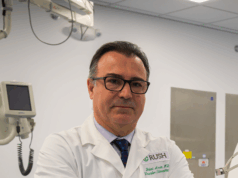
European Radiology Experimental has recently published a study on a new augmented reality system that is able to accurately guide interventional oncology procedures. A three-step experiment proves this system is precise and reliable enough to facilitate image guidance critical to the success of interventional oncology procedures.
The developers of a new augmented reality system, Endosight, have now published a study in European Radiology Experimental, which finds that this system can be utilised to guide procedures in interventional oncology. Using a back-face camera and a tablet PC to visualise the patient, the system projects 3D images of body structures such as organs, lesions, and vessels on the video image of the patient. The projections are extracted from pre-operative CT and/or MR scans, and 3D change angles depending on the corresponding camera direction of the tablet. This gives the interventional oncologist the experience of seeing through the patient.
“Through specific sensors, this system allows the interventional radiologist to literally see through the patient, and therefore to target lesions in real time without the need for other imaging technologies”, Luigi Solbiati, professor of Radiology from Humanitas University in Milan, Italy, explains.
Reliable and precise
It is a novel finding that the augmented reality system can guide procedures, as precise image guidance is critical to the success of procedures in interventional oncology. The authors concluded that their system is reliable and precise, as extremely high targeting accuracy (below 5mm) was achieved with experiments based on three models—an anthropomorphic trunk model, a porcine model, and a cadaver model. A thermal ablation procedure was simulated on these models, from which it followed that the projections of the augmented reality system very accurately depicted the location of the needle within the organs. The benefit of guiding procedures with augmented reality is that the need for extra real-time intraprocedural imaging such as CT and/or MRI – and thereby exposure to ionising radiation, is avoided. The Milan-based company that develops the Endosight augmented reality system, R.A.W. Srl, employs five of the eight authors of this study, who helped to develop the system.
Luigi Solbiati (Humanitas University, Milan, Italy) speaks to Interventional News speaks about this new augmented reality system.
How does augmented reality work in the context of interventional oncology procedures?
After acquiring cross-sectional (CT or MRI) scans and performing 3D reconstruction, augmented reality allows physicians to visualise patient’s organs and targets just through a pair of googles, in an easy and straightforward way, without the need for any other imaging modality. Augmented reality also allows the precision targeting with conventional needles, electrodes, and antennas of any nodule previously detected by CT or MRI, at any distance from the skin.
What are the main advantages of using augmented reality in this way?
The main advantages of using augmented reality in interventional oncology are the following:
- Having the possibility to easily and precisely target the real centre of nodules, thanks to the 3D visualisation in real-time. This is particularly important for ablative procedures, in order to achieve homogeneously thick ablative margins all around the volume of nodules.
- Significant shortening of the time needed to perform the procedure, compared to CT or MRI guidance.
- Overcoming the limitations of ultrasound guidance: 2D visualisation, impossibility to visualise organs (lung, bones), difficulty or impossibility to visualise nodules located in critical areas (for example, tumours in the liver dome).
- Significant shortening of the learning curve of interventional procedures.
- No risk of radiation for patients and operators.
- Capability to let all the operators, fellows, students, and other users see exactly what the main operator sees and does, given that the images of the procedure can be simultaneously broadcast to an unlimited number of googles in the same interventional room. This can be extremely useful in the teaching of how to perform interventional procedures.
Do you foresee the use of augmented reality becoming standard practice? If so, what do you think the challenges are with implementing this change?
As has always occurred in the history of medicine, it will take time to shift standard practice. There are many reasons for this lag in augmented reality becoming standard practice for the guidance of interventional procedures, such as the need for simplifying and refining the technology itself, and the traditional difficulty of convincing particularly skilled operators to abandon conventional guidance systems (based on 2D visualisation) and move to a totally new modality, based on 3D visualisation. There will certainly be a phase in which traditional guidance modalities will be used side by side with augmented reality in order to verify the precision of targeting before starting ablative procedures. In my opinion, two completely different populations of users (opinion leaders and young operators particularly skilled in the use of new technologies) could lead the remaining majority of operators toward this change.
How do you see augmented reality systems changing interventional oncology?
Enabling a larger number of non-expert clinicians to safely and precisely perform interventional procedures, thus ultimately increasing the number of procedures performed throughout the world.
What are the clinical ramifications of the study published in European Radiology Experimental, concluding that the Endosight augmented reality system is safe, reliable and precise?
In our study, we decided to start testing the Endosight augmented reality system in a very challenging environment at the Simulation Center of Humanitas University in Milan: targeting small hepatic metastases in a cadaver with a ventilator attached to the trachea to induce simulated respiration. We were able to target both metastases with a distance of the needle tip from their geometric centre ranging from 2.5 to 2.8mm. We should soon start a clinical study in human livers and, in addition, experimental studies in other moving organs (the lung) and non-moving organs (such as the prostate and neck), where we expect to run into fewer difficulties.
How does using augmented reality for interventional oncology procedures compare to the current standard practice involving other imaging technologies?
The biggest breakthroughs in the world of guidance modalities for interventional oncology procedures in the last ten years have been image fusion of real-time sonography and pre-acquired CT or MRI and cone-beam CT. However, the first suffers from the low spatial resolution of sonography and the lack of 3D representation, while the second from the risk of ionising radiation and the need for the use of contrast agents. Augmented reality can overcome all these limitations.
What is the future for augmented reality systems in interventional oncology procedures?
This question is particularly challenging and the answer almost impossible: who could have expected only five years ago(!) that we would have shortly been able to look into a patient by simply wearing a pair of glasses?










